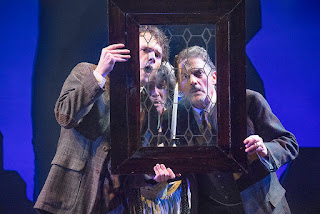As You Like It is
a pastoral comedy by William Shakespeare believed to have been written in 1599
and first published in the First Folio in 1623. The play's first performance is
uncertain, though a performance at Wilton House in 1603 has been suggested as a
possibility.
As You Like It
follows its heroine Rosalind as she flees persecution in her uncle's court,
accompanied by her cousin Celia to find safety and, eventually, love, in the
Forest of Arden. In the forest, they encounter a variety of memorable
characters, notably the melancholy traveller Jaques who speaks many of
Shakespeare's most famous speeches (such as "All the world's a stage",
"too much of a good thing" and "A fool! A fool! I met a fool in
the forest"). Jaques provides a sharp contrast to the other characters in
the play, always observing and disputing the hardships of life in the country.
Synopsis
The play is set in a duchy in France, but most of the
action takes place in a location called the Forest of Arden. This may be
intended as the Ardennes, a forested region covering an area located in
southeast Belgium, western Luxembourg and northeastern France, or Arden,
Warwickshire, near Shakespeare's home town, which was the ancestral origin of
his mother's family—who incidentally were called Arden.
Frederick has usurped the duchy and exiled his older
brother, Duke Senior. Duke Senior's daughter, Rosalind, has been permitted to
remain at court because she is the closest friend and cousin of Frederick's
only child, Celia. Orlando, a young gentleman of the kingdom who at first sight
has fallen in love with Rosalind, is forced to flee his home after being
persecuted by his older brother, Oliver. Frederick becomes angry and banishes
Rosalind from court. Celia and Rosalind decide to flee together accompanied by
the court fool, Touchstone, with Rosalind disguised as a young man and Celia
disguised as a poor lady.
Rosalind, now disguised as Ganymede ("Jove's own
page"), and Celia, now disguised as Aliena (Latin for
"stranger"), arrive in the Arcadian Forest of Arden, where the exiled
Duke now lives with some supporters, including "the melancholy
Jaques", a malcontent figure, who is introduced weeping over the slaughter
of a deer. "Ganymede" and "Aliena" do not immediately
encounter the Duke and his companions. Instead, they meet Corin, an
impoverished tenant, and offer to buy his master's crude cottage.
Orlando and his servant Adam, meanwhile, find the Duke
and his men and are soon living with them and posting simplistic love poems for
Rosalind on the trees. (The role of Adam may have been played by Shakespeare,
though this story is said to be apocryphal.)[1] Rosalind, also in
love with Orlando, meets him as Ganymede and pretends to counsel him to cure
him of being in love. Ganymede says that "he" will take Rosalind's place
and that "he" and Orlando can act out their relationship.
The shepherdess, Phebe, with whom Silvius is in love, has
fallen in love with Ganymede (Rosalind in disguise), though
"Ganymede" continually shows that "he" is not interested in
Phebe. Touchstone, meanwhile, has fallen in love with the dull-witted
shepherdess, Audrey, and tries to woo her, but eventually is forced to be
married first. William, another shepherd, attempts to marry Audrey as well, but
is stopped by Touchstone, who threatens to kill him "a hundred and fifty
ways."
Finally, Silvius, Phebe, Ganymede, and Orlando are
brought together in an argument with each other over who will get whom.
Ganymede says he will solve the problem, having Orlando promise to marry
Rosalind, and Phebe promise to marry Silvius if she cannot marry Ganymede.
Orlando sees Oliver in the forest and rescues him from a
lioness, causing Oliver to repent for mistreating Orlando. Oliver meets Aliena
(Celia's false identity) and falls in love with her, and they agree to marry.
Orlando and Rosalind, Oliver and Celia, Silvius and Phebe, and Touchstone and
Audrey all are married in the final scene, after which they discover that
Frederick also has repented his faults, deciding to restore his legitimate
brother to the dukedom and adopt a religious life. Jaques, ever melancholic,
declines their invitation to return to the court, preferring to stay in the
forest and to adopt a religious life as well. Rosalind speaks an epilogue to
the audience, commending the play to both men and women in the audience.






































